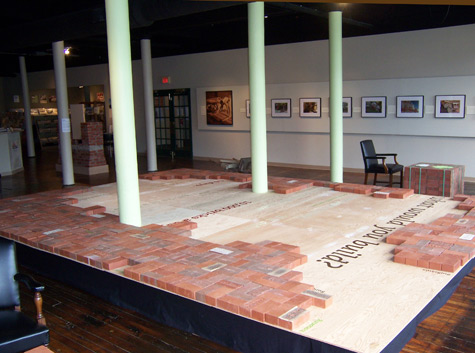Museum L-A synthesizes history and art
By ANNIE LARMON | November 4, 2009
 REMAKING THE OLD “Of Brick” by Christina Bechstein with Meghan O’Connell. |
Museum L-A is sequestered in the far end of the Bates Mill Complex in downtown Lewiston, with a bold red and yellow awning announcing its presence and trumping its otherwise unassuming facade, which might otherwise be lost in the sea of industrial brick and concrete. I was drawn to the museum to check out an interactive installation by sculptor Christina Bechstein in collaboration with type artist Megan O’Connell, entitled “Of Brick,” though I didn’t know much about the museum or its goals. What I found was an impressive effort to revitalize and engender community in Lewiston-Auburn. Presenting L-A’s cultural and industrial history through documents, artifacts, and contemporary art, Museum L-A takes an exciting holistic approach to honor the personal stories behind the infrastructure of the twin cities.
In the current exhibit “Portraits & Voices: Brickyard Roads,” 26 portraits of brickmakers line the walls of the gallery. The photos, taken by Mark Silber, are supplemented by highlights of oral histories conducted by Andrea L’Hommedieu, giving voice to the individuals and character to their work. The show includes archival photos from Morris Brick Company and Dennis Brick Company, dating back to the 1930s, illustrating the brick-making process and a timeline of events regarding the brickyards. Grounding the photos in today’s community, and evincing a certain camaraderie generated by the presentation, are Post-It notes that visitors have affixed to the photos, identifying individuals in the photos, or making slight corrections to information.
Bechstein and O’Connell’s “Of Brick” provides a critical and inquisitive approach to the otherwise document-oriented exhibit, another way to understand the fundamental importance in the role of the workers and to consider social implications and realities of brick construction. The piece consumes about a third of the gallery floor space, in the form of a plywood stage supporting an unfinished “carpet” composed of three types of brick made at Auburn’s own Morin Brick. Text taken from brickworkers’ oral histories is interwoven with the Tetris-ed bricks, infusing the otherwise insignificant objects with meaning, connecting them to human hands, and weighting the ephemeral. Words and phrases are etched into the bricks themselves, or cut from vinyl and adhered to bricks, while larger ideas and snippets of workers’ accounts are adhered directly to the exposed plywood, slowly being covered by the developing carpet.
The stage bestows new importance on the bricks, giving priority to the question of brick-making as art, which arises in the oral histories. In isolating or differentiating bricks with text, the viewer is encouraged to focus on the craft of producing a single brick, as they are encouraged to consider the individuals responsible for the fundamental elements of our urban spaces. Over the course of the next year workshops will be held for members of the community, who will be invited to carve into unfired bricks that will then become a part of the growing sculpture. Eventually, the bricks will be used in the museum’s new space in the Camden Yarns mill, one of Lewiston’s first cotton mills, completing the cycle.
Annie Larmon can be reached at aglarmon@gmail.com.
“PORTRAITS AND VOICES: BRICKYARD ROADS” | Through July 2010 | at Museum L-A, Bates Mill Complex 1, 35 Canal St, Lewiston | 207.333.3881
 Topics
Topics:
Museum And Gallery
, Christina Bechstein, Christina Bechstein, Megan O'Connell, More  , Christina Bechstein, Christina Bechstein, Megan O'Connell, Annie Larmon, Less
, Christina Bechstein, Christina Bechstein, Megan O'Connell, Annie Larmon, Less 